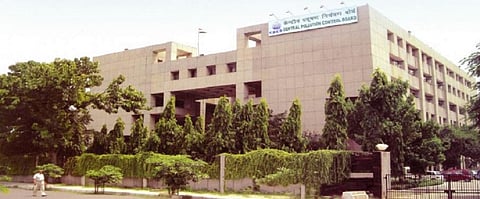India’s pollution control boards were weakened over the last 14 years, as environment ministry lacks roadmap
Around 49 per cent of the sanctioned positions in state pollution control boards (SPCB) and pollution control committees (PCC) are vacant, Ashwini Kumar Choubey, Union minister of state for environment, forest and climate change (MoEF&CC) informed the Rajya Sabha. He was responding to a question on vacant positions in the country’s SPCBs.
SPCBs from Arunachal Pradesh and Nagaland do not have any vacant posts. The number of vacant posts is less than 10 per cent in the SPCBs / PCCs of Goa, Mizoram, Sikkim and Chandigarh. SPCBs / PCCs of Bihar and Jharkhand have more than 75 per cent of sanctioned posts vacant.
Some of the other major states with high population and industries have vacant posts as high as 50 per cent. These include the SPCBs / PCCs of Andhra Pradesh, Chhattisgarh, Haryana, Karnataka, Kerala, Madhya Pradesh, Manipur, Uttrakhand and Delhi. The data revealed that in spite of an increase in the number of industries, the regulatory authorities have not been strengthened accordingly.
Choubey was asked four questions: First and second were related to the staff crunch in SPCBs and CPCB, third on the roadmap to fill the vacant post and last one whether the vacancies were affecting the performance of CPCB or SPCBs.
To the third question on the timeline for filling up vacant positions in CPCB, he referred to an advertisement published in December 2022. For SPCBs / PCCs, he informed that the responsibility lies with the concerned state government and Union territory.
To the last and important question on whether the lack of human resource is hindering the CPCB and SPCBs to discharge their responsibilities, there was no reply except on line: “Availability of adequate manpower in these institutions is very important for effective discharge of their functions and duties.”
CSE’s study on SPCB in 2009
Delhi-based non-profit the Centre for Science and Environment did a study titled Turnaround in 2009 to understand the limitation with SPCB and suggested a roadmap to reform the environmental regulatory body in the country.
The study found the issue of high vacant posts way back in 2009 and the problem remains the same in 2023. The comparison of data from CSE’s study and the Union minister of state’s information throws up some interesting facts.
Maharashtra state pollution control board had sanctioned a staff strength of 743 in 2009, which increased to 839 in 2023. The sad part is that the number of vacancies increased from a mere 57 in 2009 to 353 in 2023. This clearly shows that in spite of an increase in the number of sanctioned posts, the number of working staff decreased from 686 in 2009 to 486 in 2023.
In the case of West Bengal State Pollution Control, the sanctioned staff decreased from 328 in 2009 to 309 in 2023. The number of vacancies increased from 86 in 2009 to 122 in 2023.
Odisha SPCB increased its sanctioned staff strength from 220 in 2005 to 369 in 2023. Though the sanctioned staff increased by 149, the actual increase in workforce was only from 170 in 2005 to 188 in 2023.
The findings illustrate that in the last 14 years, instead of strengthening SPCBs / PCCs in the country, an effort was made to weaken them in the name of ‘ease of doing business’.
The following initiatives were taken since 1984 to strengthen SPCBs / PCCs / CPCB but their recommendations were never implemented on the ground.
- The Bhattacharya Committee, 1984
- The Belliappa Committee, 1990
- The ASCI Study, 1994
- Planning Commission, 2000
- Menon Committee, 2002
- SC Order, October 2003
- MoEF Directions to all CSs, July, 2005
- CRISL 2005 on MPCB
- SCMC report, March 2007
- 192nd Report of Department Related Parliamentary Standing Committee on Science, Technology, Environment and Forests presented in the Lok Sabha, October 2008
- Orders from HC & NGT
- IIM Lucknow 2010 for CPCB
Need of the hour
The Government of India has numerous policies and plans to provide clean air and clean water to its citizens such as the National Clean Air Programme, National Mission for Clean Ganga and restoration of polluted river stretches.
Such a programme will not achieve success if environmental regulatory authorities are not strengthened and given vision to do what they were envisaged to do when they were formed in 1974. The CSE study in 2009 also highlighted the fact that SPCBs are loaded with administrative staff. The 2009 study, for instance, informed that Maharashtra Pollution Control Board, Chhattisgarh Environmental Conservation Board, Tamil Nadu Pollution Control Board and West Bengal State Pollution Control Board had 55, 53, 57 and 55 per cent administrative staff respectively.
The functions of the state boards are highly technical in nature and involve monitoring of industries and implementing programmes and policies for pollution control. Therefore, it is not only the number of officials but also the quality of the officers which needs to be regulated. Following are the recommendations to strengthen environmental governance regimes in the country:
- State-wise study to understand actual manpower required by CPCB / SPCBs / PCCs and timeline to fill it
- SPCB should have own source of revenue generation: Explore new source of revenue to make SPCBs financially self-sufficient and work independently
- Chairperson of SPCB should be technical person and outside of government: It will reduce the interference of state government in day-to-day working of SPCBs / PCCs
- Making SPCBs accountable: Each board should come with long-term vision plan and regular annual plan based upon which their performance could be judged


